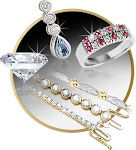How to Determine the Price Value of Color in Gemstones
Gemstones may come in a rainbow of colors, but the jewelry industry uses a universally defined system to grade it. Color accompanies clarity, cut, and carat weight to make up the 4C's and can greatly affect the aesthetic value of gemstones. Use the following tips to accurately evaluate the color of gemstones by yourself.
Evaluating Color of Gemstones by Using the GIA or Munsell Color Grading System
It utilizes a plastic set made up of 324 color pieces to serve as standard references. If a certain color is found missing from the system, interpolation can be performed to come up with more than 760 additional shades.
The GIA or Munsell system is made ideal for judging the color of gemstones because they are built with 3D plastic pieces that resemble faceted gemstones.
Elements of Color
The color of gemstones should be judged according to the three main elements:
Hue This is the first impression we obtain from viewing colors. It is what makes rubies red, sapphires blue, emeralds green, and amethysts purple. Hues have a natural order and they are red, yellow, green, blue, and lastly purple. Chroma or Saturation This element refers to the vividness, purity, strength, or intensity of a given color. Gemstones with low chroma are referred to as weak while those with high levels of saturation are called vivid or strong. Saturation of colored gemstones may be classified as the following in ascending order: grayish or brownish, slightly brownish or grayish, very slightly grayish or brownish, moderately strong, strong, and lastly vivid.
Value or Tone This is what makes you think of red as light or dark red. Gray as well as black and white are referred to as neutral or achromatic colors because they don't possess any hue. Colors with hues are referred to as achromatic colors. GIA uses a numerical system, with its written definitions, to evaluate neutral and achromatic colors alike. For transparent colored gemstones, however, only grades or tones two to eight are considered.
0 colorless or white
1 extremely light
2 very light
3 dark
4 very dark
Treatments Used for Changing Colors of Gemstones
When shopping for colored gemstones, another question you should definitely ask and one you couldn't evaluate without a definite honest answer is if the color is natural or applied. There are several commonly used and accepted color treatments that are applied to gemstones in order to change their appearance like heat treatment, irradiation, dyeing, and straining.
Heat Treatment This is the most commonly utilized and one of the oldest treatments for modifying the color of gemstones today. This treatment may use temperature ranging from 100 degrees Celsius to more than 2000 degrees Celsius and improves color distribution as well as reducing visibility of flaws.
Irradiation Low or high electromagnetic waves or energy particles are used to change the color of a given gemstone. With irradiation, certain gemstones have their colors enhanced. Bleached, off-color pearls will obtain a darker tint. Brown or light yellow diamonds can become colored. Colorless quartz may turn into smoky quartz. Colorless as well as pale pink and dark blue beryl may become yellow or maxixe-type respectively. Time, light, and heat may, however, cause the color for treated beryl jewelry to fade.
Dyeing and Straining This is the major term used to refer to various techniques utilizing a foreign and differently colored substance to modify the color of a given gemstone. Rarity is determined by the gem's color
If there is one appealing aspect of gemstones that up to this moment continuously lures women to be inclined toward it, that would be its bedazzling sparkle and exquisite colors. Among all gemstones the precious stones are the most dazzling of them all which includes sapphires, emeralds and rubies.
The aforementioned gemstones are popular due to their striking colors such as blue, red and green. While sapphires among the three other gemstones have other variety in terms of its color, which includes yellow, green and pink.
Nonetheless, all gemstones have their own respective appealing color which adds to its daintiness. Gems also have other color variations like red, green and blue.
Your desire matters
An exceptional advantage that is offered by gemstones to its clients is that they have all the freedom to select the color which they prefer. In line to that, most of the gems that are intense and richest in terms of its color merit higher market value as compared to others. For instance the emerald is known for its various shades of green, however the most famous color is the bluish green which also happens to be the most expensive kind.
Related post understanding clarity and transparency
12/29/2008
How to Rarity is determine and the price value by the gem's color ?
Labels:
colour gemstone
Subscribe to:
Post Comments (Atom)





0 comments:
Post a Comment